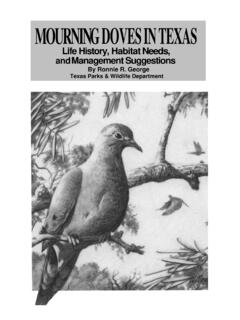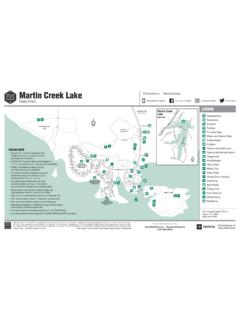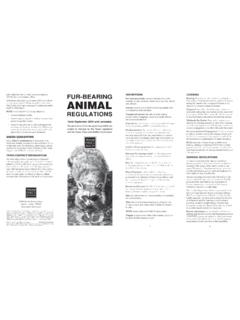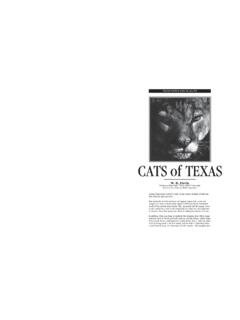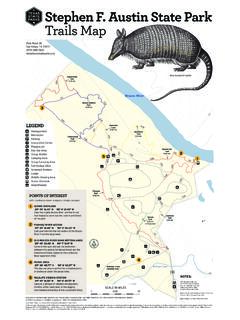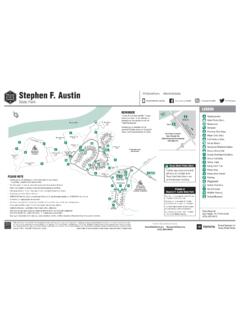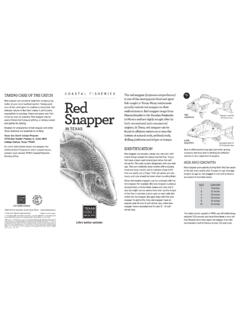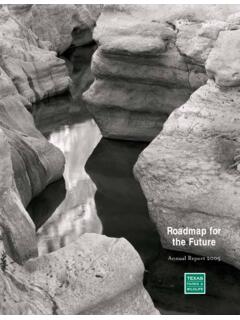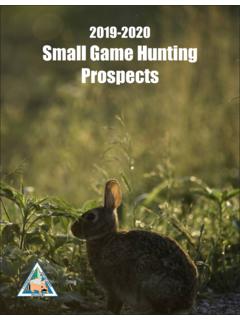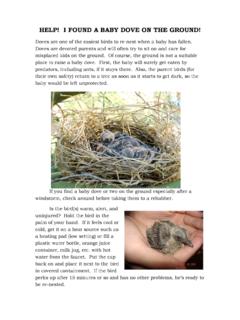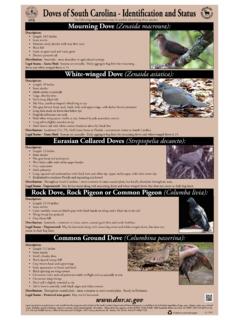Transcription of A comparison of lead and steel shot loads for harvesting ...
1 Original ArticleA comparison of Lead and steel Shot Loadsfor harvesting mourning DovesBRIAN L. PIERCE,1 Institute of Renewable Natural Resources, Texas A&M University, College Station, TX 77843-2258, USATHOMAS A. ROSTER,1190 Lynnewood Boulevard, Klamath Falls, OR 97601, USAMICHAEL C. FRISBIE,Texas Parks and Wildlife Department, 4200 Smith School Road, Austin, TX 78744, USACOREY D. MASON,Texas Parks and Wildlife Department, 4200 Smith School Road, Austin, TX 78744, USAJAY A. ROBERSON,Texas Parks and Wildlife Department, 4200 Smith School Road, Austin, TX 78744, USAABSTRACTWith approximately 100 million shots fired at mourning doves (Zenaida macroura) annually, itis incumbent on managers to determine whether changes in ammunition will substantially alter harvestmetrics or hunter satisfaction.
2 We compared mourning dove harvest metrics for 1 lead (Pb 71/2, 32 g) and 2steel (Fe 7 and Fe 6, 28 g) 12-gauge ammunition types using a double-blind field test in central Texas, were no differences in the number of attempts, or number of shots fired among ammunition were unable to distinguish the ammunition type being used in the field, and we detected norelationship between ammunition type and level of hunter satisfaction. Field analyses detected no differencein doves bagged per shot, wounded per shot, bagged per hit, or wounded per hit among the 3 ammunitiontypes. Necropsy analyses detected no difference in the proportion of birds with through-body strikes, meanpenetration depth of through-body strikes, or mean embedded pellet depth among ammunition and choke combinations that produced higher pattern densities yielded more hits per shot andproduced more total strikes per bird, resulting in a higher percentage of birds with embedded pellets, moreembedded pellets per bird, and a higher proportion of birds with broken legs.
3 All 3 ammunition typesretained sufficient lethality to harvest mourning doves under typical hunting conditions. Our resultsdemonstrate that when the ammunition type used provides sufficient lethality for pellets to penetrate vitalorgans, pattern density becomes the primary factor influencing ammunition performance. 2014 TheAuthors. TheWildlife Society Bulletinis published by The Wildlife SocietyKEY WORDS ammunition, lethality research, mourning dove, nontoxic, shotgun, shotshell, Texas, toxic shot,wounding,Zenaida lead (Pb) shot has been linked to acute toxicosis inwildlife (Bellrose 1951, Mudge 1981, Schwab and Daury1989, Daury et al. 1993). As a result, regulations limiting orbanning the use of Pb shot have been enacted by 29 countriesincluding the United States ( Department of theInterior 1976, Avery and Watson 2009).
4 Recent researchhas focused attention on prevalence of Pb toxicosis in uplandgame birds (Keel et al. 2002, Butler et al. 2005, Stevensonet al. 2005, Strom et al. 2005, Thomas et al. 2009), and inspecies that scavenge on the Pb-contaminated remains ofharvested animals (Clark and Scheuhammer 2003, Samourand Naldo 2005, Fisher et al. 2006, Hunt et al. 2006, Martinet al. 2008). Because of growing concern over use of Pbammunition, several groups have called for regulationsrestricting Pb shot use (Nontoxic Shot AdvisoryCommittee 2006, Avery and Watson 2009, The WildlifeSociety 2009), while other organizations have called for totalbansonallPb-basedammunition(Keatsan dWolf2009,Painet al.)
5 2009, Center for Biological Diversity et al. 2010).Historically, hunters in the United States have beenskeptical about the effectiveness of nontoxic shot for huntingpurposes ( Department of the Interior 1976, Mikulaet al. 1977, Smith and Townsend 1981, Humburget al. 1982, Hebert et al. 1984). To address hunter concerns,research ( , lethality tests) has been completed comparingPb and nontoxic ammunition harvest metrics for severalspecies. This research included laboratory tests usingtethered game farm mallards (Anas platyrhynchos; Bellrose1953, Andrews and Longcore 1969, Kozicky andMadson 1973, Cochrane 1976) and controlled tests usingflighted game farm mallards (Nicklaus 1976).
6 Field testsconducted under actual hunting conditions have beencompleted for wild ducks (Kimball 1974, Mikulaet al. 1977, Humburg et al. 1982, Hebert et al. 1984),large-sized wild geese (Branta canadensis; Anderson andRoetker 1978, Anderson and Sanderson 1979), medium-sized wild geese (B. canadensis; Smith and Roster 1979), andmixed wild waterfowl (Brownlee et al. 1985). To date,Received: 29 August 2012; Accepted: 18 July 2014 Published: 30 November 2014 This is an open access article under the terms of the Creative CommonsAttribution-NoDerivs License, which permits use and distribution inany medium, provided the original work is properly cited and nomodifications or adaptations are : Society Bulletin 39(1):103 115; 2015; DOI: et al.
7 mourning Dove Ammo Comparison103relatively few upland game bird tests have been tests included a laboratory study using tethereddomestic turkeys (Meleagris gallopavo; Roster 1990), a fieldstudy comparing steel (Fe) loads using released pheasants(Phasianus colchicus; Bihrle 1999, 2001), and a field test oflimited sample size on mourning doves (Zenaida macroura;Anderson et al. 1980). mourning doves are the most abundant and widely huntedgame species in North America (Aldrich and Duvall 1958,Grue et al. 1983, Baskett and Sayre 1993, Peterjohnet al. 1994). In 2011, an estimated 955,700 hunters spent days afield, and harvested million mourningdoves (Seamans et al.)
8 2012). Texas (USA) alone hostsapproximately 250,000 mourning dove hunters each year,and dove hunting contributes over US$300 million to theTexas economy annually ( Department of the Interioret al. 2002, Johnson and Polk 2004, Southwick Associates2007, Kruse 2011). Given the magnitude of the annualmourning dove harvest, and because dove hunters expend arelatively high volume of ammunition per dove bagged(approx. 4 8 shells/bird harvested; Nelson 1957, Lewis andLegler 1968, Haas 1977, Kendall et al. 1996), any regulationsaffecting dove hunting ammunition could have relativelylarge economic and environmental ramifications (NontoxicShot Advisory Committee 2006, Western Association ofFish and Wildlife Agencies 2010).
9 Previous lethality studies (controlled and field) haveaddressed concerns in waterfowl or larger upland game birdspecies, but relatively few have focused specifically onsmaller game birds ( ,<200 g), or have utilized smallershot sizes ( , smaller than No. 4 shot or mm). Anunpublished Illinois (USA) mourning dove test (Andersonet al. 1980) was the only study focusing on small game , only Anderson et al. (1980) and Hebert et al.(1984) tested ammunition containing pellets of a sizesuitable for mourning dove or other game birds ofdiminutive body size ( , mm or No. 4 shot). Asa result, wildlife managers cannot predict whether changesin ammunition use (imposed or voluntary) will alter harvestmetrics ( , bagged per shot, wounded per shot) inmourning dove or other small upland game birds, andtherefore require changes in harvest management ( , baglimits and/or season length).
10 Our objective was to determine whether changes inammunition use could alter harvest metrics in mourningdove. We assessed the performance of the most popular Pbshot load currently being used by Texas dove hunters, withthe most likely to be used nontoxic alternative, under fieldconditions. We compared ammunition characteristics (pat-tern count and pattern efficiency), hunter shot outcomes(harvest metrics), and terminal ballistics (necropsy metrics)among 1 Pb and 2 Fe ammunition types of comparable pelletweight, shot charge (payload) weight, and muzzle these data, we evaluated whether ammunitionperformance was governed primarily by pellet density, orif ancillary factors determined ammunition performance( , load pellet count, pellet hardness, pellet size, patterndensity, or choke selection).
